Recent Water Damage Posts
Preventing Water Damage from Appliances | SERVPRO of Downtown Las Vegas
8/12/2024 (Permalink)
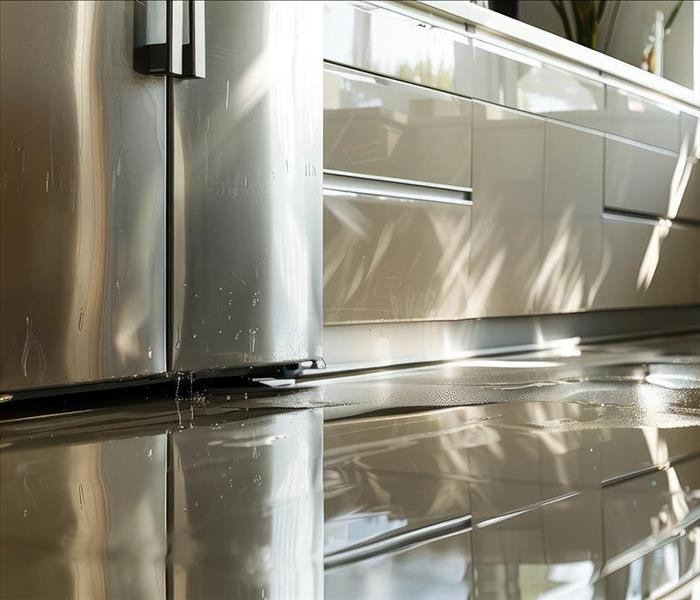 When appliances leak in your Las Vegas home, call SERVPRO of Downtown Las Vegas to fix it fast!
When appliances leak in your Las Vegas home, call SERVPRO of Downtown Las Vegas to fix it fast!
Water damage from household appliances like dishwashers and washing machines can lead to costly repairs and extensive cleanup efforts. Fortunately, with proper maintenance and preventive measures, you can reduce the risk of appliance-related water damage in your home.
SERVPRO of Downtown Las Vegas offers valuable tips below to help you safeguard your property from these common sources of water damage.
Regular Maintenance for Dishwashers
Dishwashers are a convenient appliance that many homeowners rely on daily. However, without proper maintenance, they can become a source of water damage. To prevent leaks and other issues, follow these maintenance tips:
- Inspect the seals and gaskets: Over time, the seals and gaskets around the dishwasher door can wear out or become damaged, leading to leaks. Regularly inspect these components for signs of wear and tear, and replace them as needed to maintain a watertight seal.
- Clean the dishwasher filter: Most dishwashers are equipped with a filter that traps food particles and debris. A clogged or dirty filter can impede drainage and cause water to overflow. Clean the filter regularly to ensure proper drainage and prevent water damage.
- Check for loose connections: Periodically inspect the water supply line and connections behind the dishwasher for any signs of leaks or loose fittings. Tighten connections if necessary to prevent leaks.
- Run maintenance cycles: Some dishwashers offer maintenance cycles that help clean and maintain internal components. Run these cycles periodically to prevent buildup of soap scum, debris, and mineral deposits that can affect the dishwasher's performance.
Preventing Washing Machine Mishaps
Washing machines are another common culprit of water damage in homes. To avoid potential flooding and water damage from your washing machine, consider the following preventative measures:
- Inspect hoses regularly: Check the hoses connecting your washing machine to the water supply for signs of wear, cracks, or bulges. Replace hoses every five years or sooner if you notice any damage to prevent leaks or bursts.
- Install a leak detection device: Consider installing a leak detection device near your washing machine that can alert you to leaks or excessive moisture. These devices can help you catch leaks early and prevent extensive water damage.
- Use the appropriate amount of detergent: Using too much detergent can create excess suds that may overflow from the washing machine during the cycle. Follow the manufacturer's recommendations for detergent usage to avoid this issue.
- Level the washing machine: Ensure that your washing machine is properly leveled to prevent it from vibrating excessively during the spin cycle. Excessive vibration can damage the machine and cause leaks.
Additional Tips for Water Damage Prevention
In addition to maintaining your appliances, there are several other steps you can take to prevent water damage in your home:
- Monitor your water bill: Keep an eye on your water bill for any sudden increases, as this could indicate a hidden leak.
- Know the location of your main water shut-off valve: In case of a water emergency, it's essential to know how to shut off the main water supply to your home to minimize damage.
- Consider installing a water leak detection system: These systems can alert you to leaks or abnormal water usage patterns, providing early warning of potential water damage.
By following these preventive measures and staying vigilant, you can reduce the risk of water damage from household appliances in your home. However, if you do experience water damage, SERVPRO of Downtown Las Vegas is Here to Help®. Our experienced team specializes in water damage restoration and can assist you with cleanup and restoration efforts to get your home back to its preloss condition quickly and efficiently.
Don't wait until it's too late. Contact SERVPRO of Downtown Las Vegas today for expert water damage restoration services and peace of mind.
Responding to a Flood at Your Business | SERVPRO of Downtown Las Vegas
5/21/2024 (Permalink)
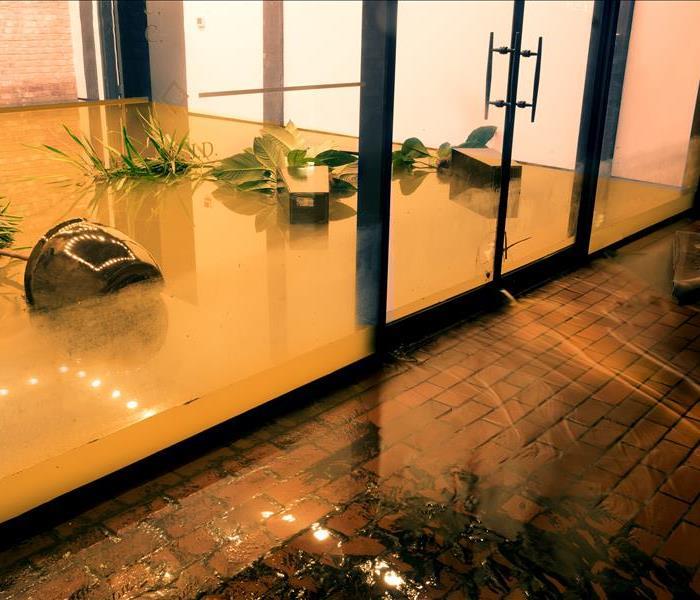 Has a flash flood invaded your business? SERVPRO of Downtown Las Vegas is here for the rescue. Call us today!
Has a flash flood invaded your business? SERVPRO of Downtown Las Vegas is here for the rescue. Call us today!
Flood situations can occur due to natural disasters or from an accident that happens at your property. Either way, they can cause significant damage in a short amount of time, leaving you with a watery mess and a lot of questions about next steps.
No matter how the water got into your business, knowing what to do before, during and after a flood can help you recover faster and stay in control of your entire situation.
Responding to a Flash Flood
If the forecast is calling for heavy rain, start getting your space ready by checking your gutter system and by pulling any patio furniture, signs or other outdoor equipment into your back room.
Consider temporarily closing up shop while the rain falls, as flooding situations can easily become dangerous for patrons that are out and about or walking around downtown. Stay away from doors and windows, and remain calm if water does start flowing into your business. It will eventually stop when the storm passes on.
Responding to a Manmade Disaster
If the situation appears to be an accident like a burst pipe or broken water line, a quick reaction is crucial for everyone’s safety. Locate the main water valve that is controlling the flood of water and shut it off.
Stopping the flow can help stop the situation from getting worse. Depending on where the flood occurred in your building, you may need to work on evacuating anyone in the general vicinity.
Flood water should always be treated with respect and you should keep your distance. Different pipes are in charge of different types of water, and it can be hard to tell what type of water is now flowing onto your floor. Clean water, gray water and even black water could be pouring out, and so exercising caution and avoiding walking through it is always a good idea.
What to Do Afterward
Move carefully around your business once the water stops flowing in. Hidden damage like loose nails, soggy walls and debris lurking under the water can quickly become dangerous situations if you aren’t careful.
You should also try to take as many photos as possible. Getting fresh images of the damage can help make the claims process much easier for your insurance company, and they give us a good indication of where to start when coming up with your restoration plan.
Then it’s time to call us! Our team will focus on getting your property back to normal as fast as we can. We will remove excess water, address repairs and tend to any cleaning needs that you may have.
Our goal is to help you overcome flood damage, but also to help you avoid long-term structural issues and mold growth. We will get you back open for business in no time at all!
Flooding situations can be overwhelming for any business owner. Call SERVPRO of Downtown Las Vegas today
Water Damage can occur during Construction
3/7/2023 (Permalink)
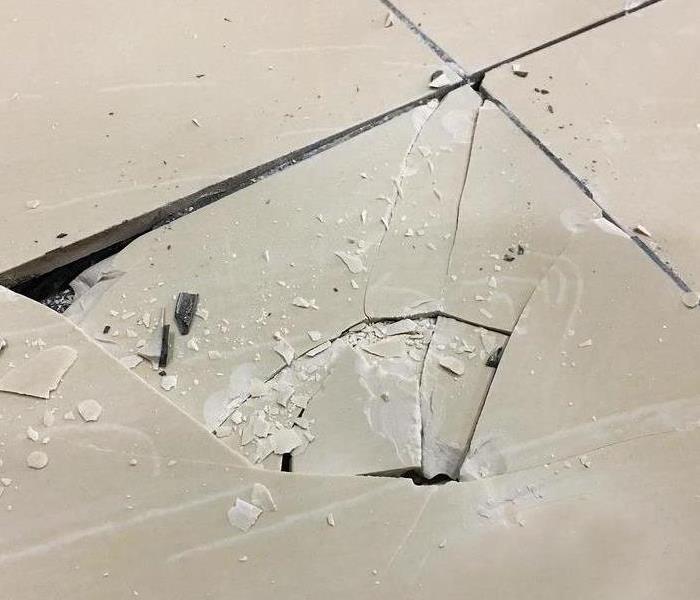 Cracked tile during reconstruction can cause water damage on the sub flooring.
Cracked tile during reconstruction can cause water damage on the sub flooring.
Construction projects often bring with them the potential for water damage. If you are planning a construction project, there are steps you can take to prevent damage from happening.
Replace or upgrade your water lines
Water pipes are an essential part of any home, but they tend to get old as time goes on. If you have an older home and notice that some of your water lines are corroded or leaking, it's best to replace them before any major damage occurs. Even if you don't notice any leaks or corrosion right now, it's still a good idea to upgrade the piping in your house so that there isn't any risk of future problems with leaking or corrosion when you least expect it.
If one pipe started leaking today, other pipes may start leaking soon after due to stress from overburdened pressure from higher levels of usage in multiple areas around town (like hot summer days). This could result in serious consequences like flooding which could cause property damage throughout homes built near rivers/streams/lakes etc.
Replace natural gas-powered appliances with electric ones
Natural gas is a fossil fuel and a greenhouse gas. It can leak into the air, where it causes health problems and contributes to global warming. Electric appliances are safer because they don't use any fossil fuels, so you won't have to worry about any of these issues with them.
Use a dehumidifier to prevent mold
A dehumidifier is a device that removes moisture from the air. It can be used to prevent mold and mildew in basements, crawl spaces and other areas prone to water damage.
Mold is one of the most common types of indoor air quality issues that homeowners face today because mold spores are microscopic fungal organisms that grow on wet materials such as wood paneling or carpeting if not properly taken care of by removing moisture from these surfaces before they become infested with spores.
Prevent leaks by insulating pipes and updating your thermostat
Insulate pipes and water heaters. Pipes can be insulated by wrapping them in an insulating blanket or using foam pipe insulation. This will help prevent the loss of heat through the walls, floors, and ceilings during winter months.
Update your thermostat. If you have an older model that doesn't automatically adjust itself based on temperature changes in your home, consider replacing it with one that does so you can have more control over how much energy is used to keep things warm or cool throughout the year. Use timers when away from home: Set up automatic timers for lights and appliances such as washing machines so they don't run when no one's around.
Water damage can be prevented
Water damage can be prevented by taking the proper precautions and using the right tools. Water damage can be expensive to repair. Water damage can happen for a variety of reasons, a pipe may burst in your home or office, or you might accidentally leave a faucet running all day long. If you have an overflowing toilet or scalding hot water running through your kitchen sink pipes, this could cause serious problems for both structural integrity as well as electrical wiring throughout your home or business premises.
Take precautions to help reduce water damage to your property during reconstruction. SERVPRO has the experience and expertise to help upgrade your home preventing water damage during a remodel.
How Does Water Affect Building Materials?
11/7/2022 (Permalink)
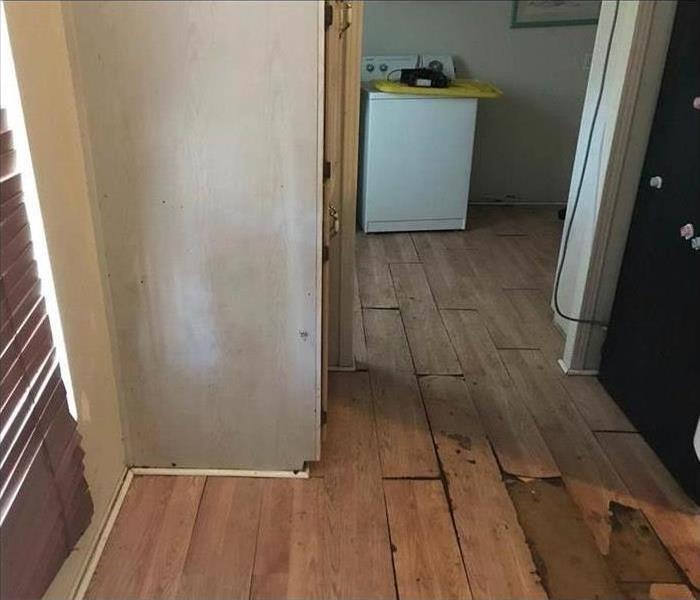 If your home has experienced water damage, SERVPRO is equipped to remediate any restoration need!
If your home has experienced water damage, SERVPRO is equipped to remediate any restoration need!
How Do Building Materials React to Water?
Water is one of the most dangerous elements to deal with in your home. It can cause damage on every level, from mold and mildew to rotting wood and even termites. Water can also be very destructive to many different building materials, such as wood, plaster, metal, and concrete. Fortunately, there are ways you can protect yourself from these issues.
Swelling Wood
If you've ever had to move a water-damaged piece of furniture and watched it crack, crumble, and fall apart as if there were some sort of zombie virus in the wood, you've experienced this phenomenon firsthand. Wood is porous and absorbs water, which can swell the fibers of the wood as well as cause small gaps between them. When this happens, the wood will shrink back to its original size when it dries out again; however, if too much moisture has been absorbed into a piece of furniture or other household item (especially from water lingering on one side), then it may be irreversibly damaged. As we all know from experience with dishes or clothing that have been soaked in the sink for too long: when you leave something wet for too long, mold growth will occur, and damage is irreversible.
Plaster and Drywall
The other two common building materials are plaster and drywall. Plaster is a very soft, malleable material that can be molded into any shape or form, then set. It's used as the finish coat in most homes and buildings to give them a smooth finish or texture. If water gets behind a wall of plaster, it can swell up quite a bit. However, if you act quickly by drying out the walls with fans and heaters attached to blowers (the same kind used for drying paint), it should be fine after some time passes — if there's no mold growth or damage from freezing temperatures while waiting for drying to occur.
Drywall is very similar to plaster except it doesn't have any give whatsoever: once you put drywall up on your walls, that's where it stays until you decide otherwise! The only way this type of material will crack apart during normal use is if there's too much moisture present within its structure.
Metal
You may have heard the expression, “Water and metal don’t mix.” While this isn’t exactly true, it does illustrate the point that metal can be damaged by water. There are three different ways that this can happen:
- Cracking of the material due to expansion and contraction caused by temperature changes.
- Corrosion, which is chemical degradation of a metal surface over time as it encounters oxygen and/or water molecules. This leads to rusting (oxidation), tarnishing (electrochemical corrosion), or pitting (galvanic corrosion).
Concrete
Concrete is a great building material, but it’s also porous and can absorb water. If your concrete isn’t cured properly or if it isn’t protected from water, it can be damaged by water.
Brick
Brick is made of clay and sand. It absorbs water, which can cause bricks to fall out of place or crack when exposed to freezing temperatures. While brick can be dried out, it takes a long time — up to several weeks depending on the size of the area affected. If your brick becomes damaged due to exposure to moisture or freezing temperatures, you may need professional help removing and replacing it.
Water can damage many common building materials, but some can be saved
Water damage is a serious problem. Water can seep into your building materials, causing them to expand or contract and crack. This can cause a host of other problems, like mold growth and rotting wood.
The cost of repairing water damage can be high, with some estimates running as high as $5 per square foot. To avoid this expensive repair bill, you'll want to act quickly when you notice signs of water intrusion in your home or on your property.
If you think that your home or business has been damaged by water, call the professionals at SERVPRO of Downtown Las Vegas. We offer free quotes for all types of restoration services in Las Vegas.
While water damage can be a major problem for building materials and structures, it's important to remember that not all buildings are the same. Different materials react differently to water, so you'll need to know how they're affected before deciding on any course of action. In some cases, it might be possible to salvage your home or business after storm damage.
Causes for and Curing of Leaky Toilets
8/25/2022 (Permalink)
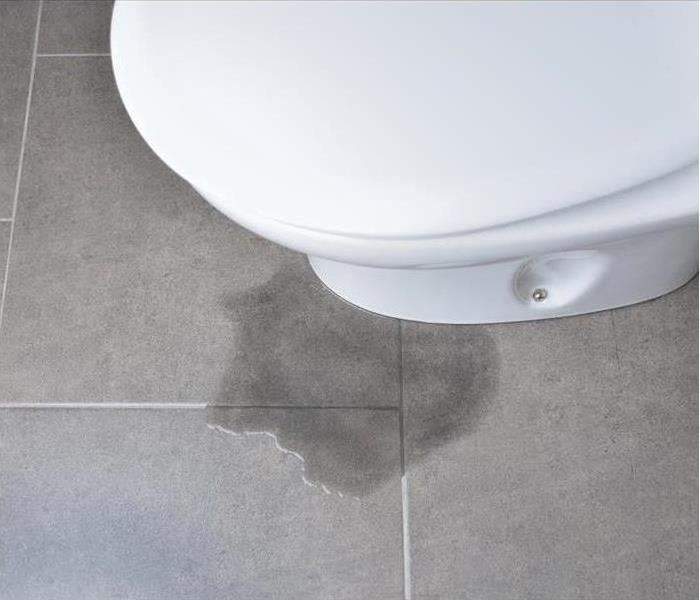 A leaking toilet should not cause panic
A leaking toilet should not cause panic
Know What Causes The Problem And How To Fix IT
Sooner or later, a leaking toilet will plague one of your bathrooms in Downtown East, NV. Before yours begins oozing sewage, know what causes the problem and how to fix it.
Toilet Leak Causes
A bathroom leak may occur for any number of reasons, including:
- A cracked tank or bowl
- Rusty pipes
- A worn flapper
- Loose or worn out base seals
- Faulty connectors
- A maladjusted flush valve
Left untreated, toilet seepage can cause serious structural damage. If floor tile warps or sink cabinets endure discoloration, contact a residential water restoration specialist to get your restroom looking “Like it never even happened.”
Toilet Leak Fix Procedure
Toilets have been known to last more than 40 years with minimal care. Despite their dependability, faults still happen. The below information may help fix your leaking toilet.
Start by tightening the bolts that secure the toilet in place. Remove the caps covering the bolts with a putty knife or screwdriver and then tighten the nuts using a wrench. Keep your aggression in check, as excessive pressure may crack the base.
If the leak continues, try replacing the wax gasket. Turn off the valve and drain as much water as possible. Hold down the handle and remove the remaining liquid with a paper towel and disposable cup. Rock the toilet back and forth until the seal breaks. Remove the toilet and scrape off the old gasket. After loosening the screws used to secure the flange, insert the repair strap. Finally, place the new gasket on the ground and complete reinstallation.
Plumbers disagree on whether caulking should be applied to toilet bases. Some government buildings require it since caulking inhibits bacterial growth. Most abstain, as doing so obscures expanding leaks. If you elect to apply caulk, use one that is resistant to mildew.
A leaking toilet should not cause panic. With a bit of effort, yours will flush properly once more.
How To Clean up After a Water Heater Leak
7/18/2022 (Permalink)
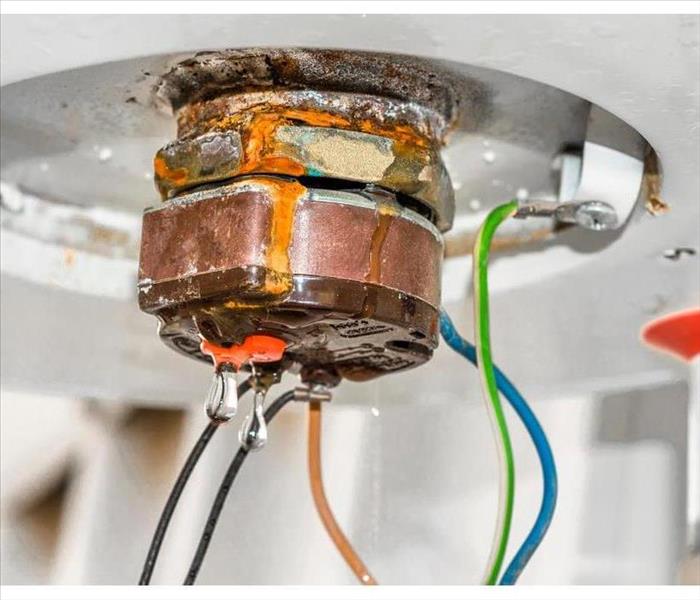 Never put off fixing a leaking water heater or cleaning up the mess left behind.
Never put off fixing a leaking water heater or cleaning up the mess left behind.
You probably rely on your water heater every day. For cooking and showering, this appliance is more than a convenience. However, it's also prone to causing problems, including flooding. A leaking water heater can send gallons upon gallons of water all over your floors, possibly affecting a variety of materials and items in your home. Knowing how to mitigate these challenges can save you a lot of time and money.
Take Care of Objects in the Area
If you don't discover a failed water heater as soon as it starts having problems, the damage may be too severe. As soon as you notice water leaking from this appliance, make sure you get all items out of the area. These include:
- Carpet
- Furniture
- Electronics
Clothes
Reduce the Risk of Shock or Electrocution
Everyone in Winchester, NV, knows that water and electricity don't mix. Before you start looking at the broken water heater, turn the power off in your home. If possible, work on the water heater without touching the water. Wear proper protective gear such as gloves and boots.
Extract the Water
It doesn't take long for a leaking water heater to leave a significant amount of water in your home. If the water covers a small area, you can gran a wet vacuum and remove the water on your own. However, if the water spreads throughout the area, you should contact a professional flood remediation company. The professionals have the right equipment and skills to do the job right.
Drying and Sanitizing
Removing the water isn't enough. To discourage the growth of mold and mildew, you need to make sure the ground, walls, and other nearby materials are completely dry. The pros will use fans and dehumidifiers to do this. The team will also use powerful chemicals to disinfect all places where there was water.
Never put off fixing a leaking water heater or cleaning up the mess left behind. Following these steps can ensure your safety.
How Flooding Affects Furnaces
3/19/2022 (Permalink)
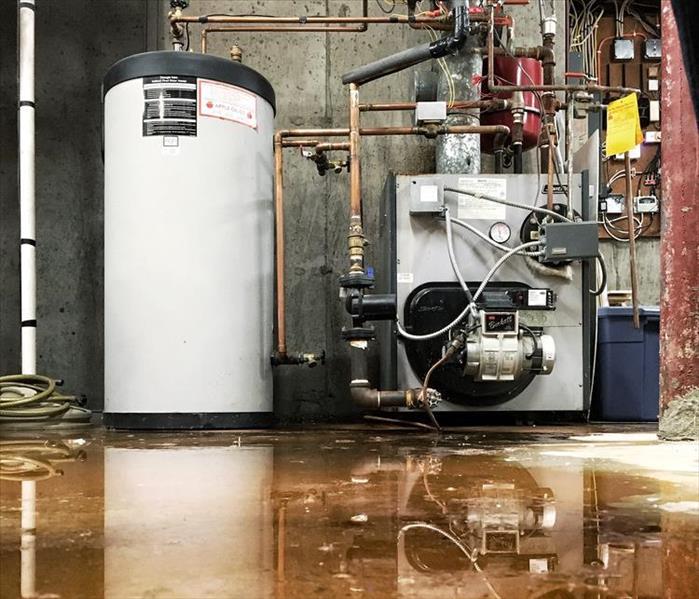 Flooding on a furnace in Las Vegas, NV.
Flooding on a furnace in Las Vegas, NV.
The Effects of Flooding on Furnaces
Many large commercial buildings have packaged rooftop units with a gas or electric boiler or a chiller with a boiler for space heating. Smaller structures that rely on conventional gas or electric furnaces can sustain serious damage from a furnace flood. Find out how to avoid the worst consequences of water damage after a pipe burst near a furnace in a building located in Las Vegas, NV.
Increased Risk of Electrical Problems
A commercial building may have a gas or electric furnace. Furnaces powered by electricity contain several components that could malfunction after being exposed to water:
- Contactor
- Heating element
- Sequencer
- Transformer
If any of these components malfunctions on a flooded furnace, the unit could trip a fuse or even blow a breaker. It is important to shut off the power to a flooded electrical furnace unit to reduce fire risks.
Metal Components May Corrode
Corrosion on sensitive components such as the contactor in a furnace can cause a unit that runs on electrical power to cease to function. Corrosion is caused by a chemical reaction between the salts that occur in water and any type of metal. Iron components corrode more quickly than stainless steel. Noble metals are less reactive and prone to corrosion.
Ductwork Can Become Contaminated
After a furnace flood, residue from a unit powered by gas or oil can travel through outflow ducting and contaminate a structure. Under the worst circumstances, a furnace blowback can spread soot throughout a building. It is a good idea to arrange for air duct cleaning after any commercial furnace or heating unit suffers water damage.
A furnace flood has the potential to undermine the function of this crucial appliance and the safety of a structure. Shutting off the furnace and the circuit for an appliance powered by electricity can help to limit safety risks at a commercial building in Las Vegas, NV.
How To Handle Water Damage in a Light Fixture
1/27/2022 (Permalink)
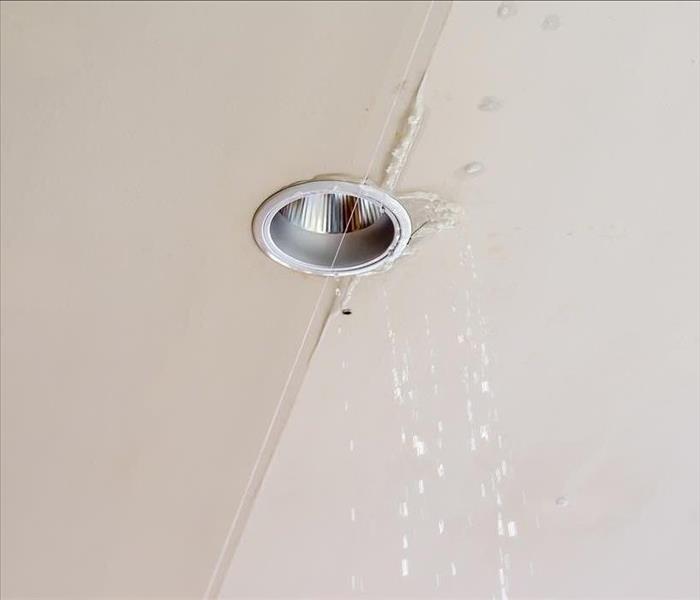 Finding water in a light fixture in your home probably isn’t your favorite discovery.
Finding water in a light fixture in your home probably isn’t your favorite discovery.
Steps To Take When Your Light Fixture Floods
A water leak is not something anyone wants to have to deal with at home. The tell-tale dripping sound alerts you to a probable leak, but when you find water in a light fixture in your home, you still have to find out where the water came from. With a little investigation and a lot of help from water remediation experts, you can hopefully take care of the leak before it causes any further damage. Here are the first few steps you need to take when your light fixture floods.
1. Locate the Source
In order to get an idea of the ceiling damage repair required, you must find out where the water originates. There are several potential sources:
- Broken pipe
- Overflowing toilet
- Leaky supply line
Each of these sources comes with its own unique repair criteria. A leaky supply line may need to be replaced before it does you any good to repair the ceiling where you found water in the light. A broken pipe will likely saturate the insulation between the floors and may affect the walls as well. An overflowing toilet means the water is contaminated and thus additional disinfection is necessary.
2. Turn off Water and Power
Before anyone approaches the light fixture, safety precautions must be taken. Shutting off the water stops the leak and helps to prevent further flooding. Turning off the breaker that feeds electricity to the light keeps the water from becoming charged.
3. Call the Professionals
A leak that affects two different floors is not a problem you want to try to resolve on your own. Restoration specialists in Medical District, NV, are trained and certified to remedy water damage in a thorough and efficient manner. By calling in the experts as soon as you notice the problem, you can avoid bigger issues and secondary damage.
Finding water in a light fixture in your home probably isn’t your favorite discovery. Quick action and professional help, however, can minimize the damage it causes.





 24/7 Emergency Service
24/7 Emergency Service







